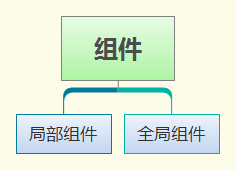Vue 学习记录三
组件
我们在编程的时候时刻提醒自己
DRY(Do not repeat yourself),组件化可以很大提高开发效率,并且是整体代码显得优雅,但首要前提是晓得怎么使用。下面,就按我的理解给大家介绍下吧。
组件可以分为局部组件和全局组件,其中最最重要的是组件之间的通信。

局部组件
举例子吧,现在Vue这么火,文字叙述太枯燥,首先声明,这些例子是在cli3搭建的脚手架环境下。新建 components/CountDown.vue 倒计时组件。
<template>
<text>
<text>{{timer.day}}天</text>
<text>{{timer.hour}}时</text>
<text>{{timer.minute}}分</text>
<text>{{timer.second}}秒</text>
</text>
</template>
<script>
export default {
name: "CountDown",
props:{
time:{
type:String,
default:'0',
}
},
data() {
return {
timer: {
day: 0, //天
hour: 0, //小时
minute: 0, //分钟
second: 0, //秒
},
ref: null, //定时器引用
futureTime: 0, //截至时间点
}
},
created() {
this.transformTime(this.time);
this.startTimer();
},
methods: {
startTimer() {
this.ref = setInterval(() => {
this.play();
}, 1000)
},
endTimer() {
clearInterval(this.ref)
},
play() {
let currentTime = new Date().getTime();
let diffNum = this.futureTime - currentTime;
if (diffNum > 0) {
//总秒数
let totalSeconds = parseInt(diffNum / 1000);
//天数
let days = Math.floor(totalSeconds / (60 * 60 * 24));
//取模(余数)
let modulo = totalSeconds % (60 * 60 * 24);
//小时数
let hours = Math.floor(modulo / (60 * 60));
modulo = modulo % (60 * 60);
//分钟
let minutes = Math.floor(modulo / 60);
//秒
let seconds = modulo % 60;
this.timer.day = days.toString().length === 1 ? '0' + days : days;
this.timer.hour = hours.toString().length === 1 ? '0' + hours : hours;
this.timer.minute = minutes.toString().length === 1 ? '0' + minutes : minutes;
this.timer.second = seconds.toString().length === 1 ? '0' + seconds : seconds;
} else {
this.endTimer();
this.timer.day = 0;
this.timer.hour = 0;
this.timer.minute = 0;
this.timer.second = 0;
}
//console.log(this.timer);
},
transformTime(formatTime) {
let futureTime = new Date(formatTime).getTime();
if (!isNaN(futureTime)) {
this.futureTime = futureTime;
}
}
},
}
</script>
<style scoped>
</style>局部组件是建好了,那么怎么使用呢?新建一个 pages/test.vue 文件,但是需要在该文件中引入并声明倒计时组件。
<template>
<view>
<!-- 3、使用局部组件 -->
活动倒计时:<CountDown :time="endTime"></CountDown>
</view>
</template>
<script>
//1、引入局部组件
import CountDown from '@/components/CountDown'
export default {
//2、声明注入局部组件
components:{
CountDown
}
data(){
return {
endTime:'2019-11-23 00:00:00',
}
}
}
</script>
<style scope>
</style>局部组件的使用步骤就像上例所示,首先定义一个组件,然后再另外一个组件里面引入并注册它,然后就可以使用啦。
另外需要提示的是prop关键字,它可以是数组或对象,用于接收来自父组件的数据。它有以下几个选项:
- type 指定数据类型。类型可以是 String、Number、Boolean、Array、Object、Date、Function、Symbol、任何自定义构造函数、或上述内容组成的数组
- default 为 prop 制定一个默认值,对象或数组的默认值必须从一个工厂函数返回
- required 定义该prop是否是必填值,Boolean 值
- validator 自定义验证函数会将该 prop 的值作为唯一的参数代入
全局组件
有些组件会被经常用到,可以将它作为全局组件,下面就举例怎么实现。
新建消息组件src/components/Message.vue
<template>
<div v-show="show" :class="`alert alert-${type} alert-dismissible`">
<button @click="close" type="button" class="close"><span>×</span></button>
{{ msg }}
</div>
</template>
<script>
export default {
name: 'Message',
props: {
// 是否显示消息框
show: {
type: Boolean,
default: false
},
// 消息框的类型
type: {
type: String,
default: 'success'
},
// 消息
msg: {
type: String,
default: ''
}
},
watch: {
show(value) {
if (value) {
this.$nextTick(() => {
this.$el.scrollIntoView(true)
})
}
}
},
methods: {
close() {
this.$emit('update:show', false)
}
}
}
</script>
<style scoped>
</style>新建src/components/index.js
import Vue from 'vue'
import Message from './Message'
const components = [Message];
for (let [key,value] of Object.entries(components)) {
Vue.component(key,value);
}在入口文件中引入全局组件,src/main.js
import Vue from 'vue'
import App from './App'
import './components'
export new Vue({
el: '#app',
components: { App },
template: '<App/>'
})注意this.$emit 触发当前实例上的事件。附加参数都会传给监听器回调。
全局组件使用Vue.component(key,value)进行注册
本作品采用《CC 协议》,转载必须注明作者和本文链接




 关于 LearnKu
关于 LearnKu




推荐文章: